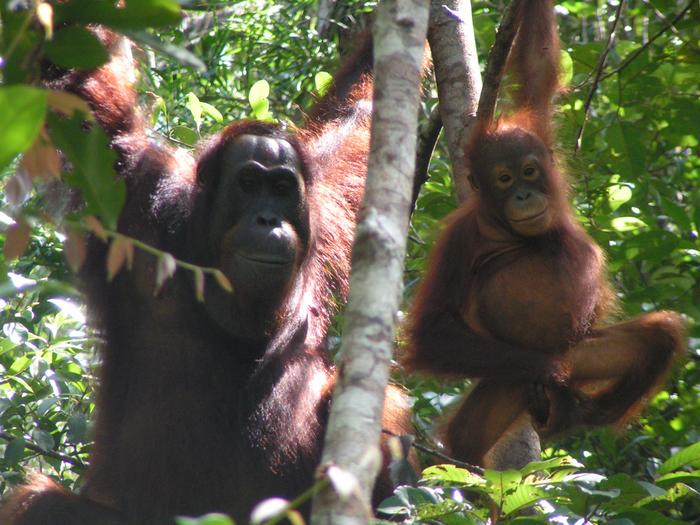A groundbreaking discovery from researchers at The University of Warwick is reshaping our understanding of the origins of complex communication in the animal kingdom. Their study reveals that wild Sumatran orangutans produce vocalizations exhibiting recursive, layered complexity previously believed to be exclusive to human language. This remarkable finding challenges the long-standing notion that nested linguistic structures are a uniquely human trait and opens new avenues for exploring the evolutionary pathways that led to human speech.
Recursion, a fundamental feature of human language, allows the embedding of phrases within phrases, enabling infinite and nuanced expression from limited elements. It can be illustrated through a seemingly simple sentence such as “The dog that chased the cat that killed the rat that ate the cheese,” which has multiple layers of nested clauses. This linguistic architecture has long been thought to underpin complex human thought and communication, setting our species apart. However, the recent analysis of orangutan alarm calls indicates that recursion’s evolutionary roots extend deeper into our shared ancestry with great apes.
The study focused on the vocal alarm calls produced by female Sumatran orangutans when confronted with various threats in their natural habitat. Using sophisticated acoustic analyses, the researchers discovered that the calls are organized into a three-tiered recursive structure. At the most basic level, individual vocal sounds form small combinations. These combinations are then grouped into larger bouts at a second level, and finally, these bouts are nested into longer series, creating an intricate hierarchy of sounds, all exhibiting rhythmic regularity.
This hierarchical, multi-layered vocal pattern presents an impressive third-order recursion—a complexity that had not been empirically demonstrated in non-human great apes before. The orangutans essentially generate vocal sequences that embed one rhythmic motif within another, akin to a complex musical composition where recurring patterns nest within larger patterns. This nuanced vocal architecture suggests cognitive capabilities for structured communication previously unattributed to orangutans.
Moreover, this complex vocal layering is not merely a static acoustic feature; it dynamically adjusts depending on the context of the threat. When these orangutans detect an immediate predator such as a tiger, their alarm calls accelerate, becoming faster and more urgent. In contrast, ambiguous or less credible threats—like an inanimate mannequin sporting bright colors—elicit slower and more irregular calling rhythms. This adaptability highlights that orangutan vocalizations are not random or instinctual noise but structured, meaningful signals tailored to convey specific information about environmental dangers.
The implications of these findings are profound, suggesting that recursion—a mechanism considered central to human language—might have emerged incrementally in common ancestors millions of years ago. It challenges the anthropocentric view that unique features of human communication suddenly appeared and instead supports a model of gradual evolutionary selection and refinement. This recontextualizes our understanding of cognitive and communicative evolution, positioning orangutans as a pivotal species for comparative linguistic and neurological studies.
Dr. Chiara De Gregorio, lead author of the study, emphasizes that the rhythmic self-embedding in orangutan vocalizations “challenges the idea that recursion is uniquely human.” This evolutionary perspective not only sheds light on orangutan cognition but also bridges gaps in the search for the origins of structured language. By investigating how orangutans encode multi-level information in their calls, researchers glean insights into the selective pressures and neurological adaptations that predate the emergence of human language.
The methodological approach in this work was rigorous and innovative, involving extensive field recordings paired with advanced rhythmic and acoustic analyses. By dissecting the temporal structure of vocal calls, the team identified patterns indicative of recursive embedding, a method aligning with cross-disciplinary research in linguistics, ethology, and evolutionary biology. The study thus exemplifies the fruitful intersection of these fields to unravel complex behavioral phenotypes in wild populations.
It is worth noting that while recursion has been suggested in songbirds and cetaceans, the multi-layered vocal motifs documented here represent a novel discovery in non-human primates. This places orangutans in a unique position to help elucidate the cognitive prerequisites for language-like communication. Additionally, recognizing layered vocal recursion in great apes proposes new frameworks for examining social cognition, memory capacity, and the neurological substrates required for processing complex hierarchical information.
The findings elevate the importance of preserving wild orangutan populations—not merely as an act of biodiversity conservation but as a crucial step toward preserving living windows into the evolutionary past. Protecting their natural habitats enables ongoing observation of these sophisticated communication systems, which may continue to yield transformative insights about the evolutionary steps leading to human linguistic abilities.
Ultimately, this research invites a reconsideration of the evolutionary narrative, suggesting that key elements of language structure have deep ancestral origins that extend beyond Homo sapiens. The orangutans’ vocal behavior exemplifies how evolutionary forces might have incrementally shaped communication systems with recursive properties essential for complex social interactions. These revelations promise to spark further research into the neurobiological and genetic foundations of language, using our closest living relatives as models.
This landmark study, published in the Annals of the New York Academy of Sciences, pushes the boundaries of our understanding and underscores the dynamic continuity between human language and animal communication. It is a powerful reminder that the capacity for complexity, embedded meaning, and adaptive vocal signaling is not the sole domain of humans but is woven into the rich tapestry of primate evolution.
Subject of Research: Animals
Article Title: Third-order self-embedded vocal motifs in wild orangutans, and the selective evolution of recursion
News Publication Date: 16 May 2025
Web References:
https://nyaspubs.onlinelibrary.wiley.com/doi/full/10.1111/nyas.15373
References:
De Gregorio, C., Lameira, A., & Gamba, M. (2025). Third-order self-embedded vocal motifs in wild orangutans and the selective evolution of recursion. Annals of the New York Academy of Sciences. https://doi.org/10.1111/nyas.15373
Image Credits: Madeleine Hardus
Keywords: Animal communication, Ethology, Evolution, Language evolution
Tags: acoustic analysis of orangutan callsanimal alarm calls analysiscomplex vocalizations in primatesevolution of animal communicationevolutionary pathways of speechgreat apes communication skillsgroundbreaking research in animal linguisticshuman language originsnested linguistic structures in naturerecursive vocalizations in animalsSumatran orangutan languagewild orangutans communication complexity





